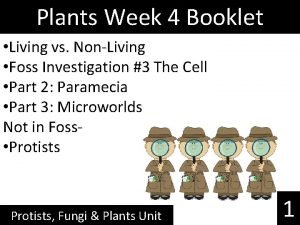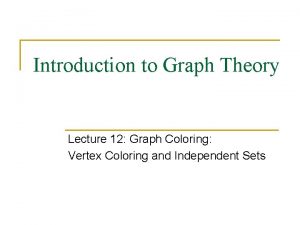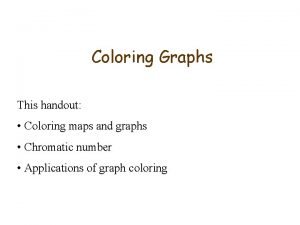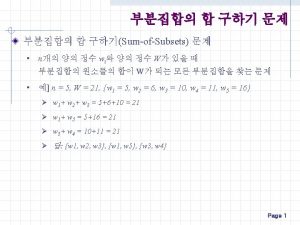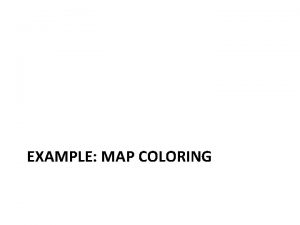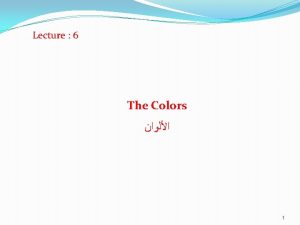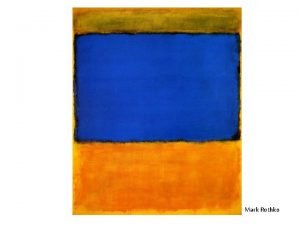13 2 COLORING GRAPHS WITH TWO COLORS Jim

















- Slides: 17

13. 2 COLORING GRAPHS WITH TWO COLORS

� Jim has six children. � Chris fights with Bob, Faye, and Eve all the time; Eve fights (besides with Chris) with Al and Di all the time; and Al and Bob fight all the time. Jim wants to put the children in two rooms so that pairs of fighters should be in different rooms. � Can he do this?

� We construct a "fighting graph": We represent each child by a node, and connect two nodes if these children fight all the time. � We get the graph in Figure 13. 4(a). (a)

Jim's task is to split the nodes into two groups so that every fighting pair is separated. A solution is shown in part (b) of the figure. FIGURE 13. 4. The fight graph of Jim's children; how to put them in two rooms; and how this translates to a 2 coloring.

� Instead of redrawing the graph putting its nodes left and right, we can indicate which child goes in which room by coloring the corresponding node black or white. The rule of the coloring is that adjacent nodes must be colored with different colors. Figure 13. 4(c) shows the corresponding coloring.

� Jim can put the children represented by white nodes in one room, and the others (represented by black nodes) in the other. Looking at Figure 13. 4(b), we notice that we have already met such graphs: we called them bipartite, since the vertex set of these graphs can be split into two disjoint sets (or parts) such that edges go only between vertices belonging to different sets. (b)

� The problem of coloring the regions formed by circles in the previous section can also be stated as a problem on coloring the nodes of graphs with 2 colors. We associate a graph with the regions formed by circles the following way: Represent every region by a vertex of the graph. Two vertices are connected by an edge in the graph if and only if the corresponding regions share a common boundary arc (just sharing a point at a vertex does not qualify).

� Which graphs are 2 -colorable (in other words, bipartite)? � It is clear that if a graph consists of isolated vertices, 1 color is enough to get a good coloring. If the graph has at least one edge, then we need at least two colors.

� It is easy to see that a triangle, the complete graph on 3 vertices, needs 3 colors to be well colored. It is also obvious that if a graph contains a triangle, then it needs at least 3 colors for a good coloring.

� But a graph need not contain a triangle and may still not be 2 -colorable. A little more involved example is a pentagon: It is easy to convince ourselves that no matter how we color its vertices with 2 colors, we'll necessarily end up with two adjacent vertices with the same color.

� We can generalize this observation to any cycle of odd length: If we start coloring any node with (say) black, then as we walk along the cycle we must color the next node white, the third node black, and so on. We must alternate with colors black and white. But because the cycle is odd, we return to the start node in the wrong phase, ending up with coloring the last node black, and so having two adjacent black nodes.

� It follows that if a graph contains an odd cycle, then it cannot be 2 -colorable. The following simple theorem asserts that nothing more complicated can go wrong: � Theorem 13. 2. 1 A graph is 2 -colorable if and only if it contains no odd cycle.

Proof. We already know the "only if" part of this theorem. To prove the "if" part. � Suppose that our graph has no odd cycle. Pick any vertex a and color it black. Color all its neighbors white. Notice that there cannot be an edge connecting two neighbors of a, because this would give a triangle. � Now color every uncolored neighbor of these white vertices black. We have to u and the new black vertices, since the new black vertices didn't belong to the neighbors of a; no edge can go between the new black vertices, because it would give a cycle of length 3 or 5. Continuing this procedure the same way, if our graph is connected, we'll end up with 2 -coloring all vertices. �

� It is easy to argue that there is no edge between two vertices of the same color: Suppose that this is not the case, so we have two adjacent vertices u and v colored black (say). The node u is adjacent to a node u 1 colored earlier (which is white); this in turn is adjacent to a node u 2 colored even earlier (which is black); etc. This way we can pick a path P from u that goes back all the way to the starting node. Similarly, we can pick a path Q from v to the starting node.

Starting from v, let's follow Q back until it first hits P, and then follow P forward to u. This path forms a cycle with the edge uv. Since the nodes along the path alternate in color, but start and end with black, this cycle is odd, a contradiction (Figure 13. 5). � If the graph is connected, we are done: We have colored all vertices. If our graph is not connected, we perform the same procedure in every component, and obviously, this will give a good 2 -coloring of the whole graph. This proves Theorem 13. 2. 1. # �

� FIGURE 13. 5. Bad 2 -coloring yields an odd cycle.

� It is worth pointing out that in the proof above we did not really have much choice: We could choose the color of the starting node, but then our hands were forced all the way through coloring the connected component of that point. Then we had a free choice for the color of the first node of the next component, but then the rest of the component was forced again. This means that we not only proved Theorem 13. 2. 1, but also gave an algorithm for finding a 2 coloring if it exists (and to find an odd cycle if it does not).
 Degree and leading coefficient
Degree and leading coefficient Color introduction
Color introduction State graphs in software testing
State graphs in software testing Comparing distance/time graphs to speed/time graphs
Comparing distance/time graphs to speed/time graphs Graphs that enlighten and graphs that deceive
Graphs that enlighten and graphs that deceive Www.coloring
Www.coloring Trophic level diagram
Trophic level diagram Transcription end result
Transcription end result Skill 17 present participles and past participle after be
Skill 17 present participles and past participle after be Respiratory system coloring page
Respiratory system coloring page Adams food coloring
Adams food coloring Welsh powell
Welsh powell Euglena living or nonliving
Euglena living or nonliving The periodic table coloring activity
The periodic table coloring activity Periodic table of elements coloring activity
Periodic table of elements coloring activity Pentecost welcome
Pentecost welcome A tree falls the way it leans quote meaning
A tree falls the way it leans quote meaning What is an independent set in a graph
What is an independent set in a graph












